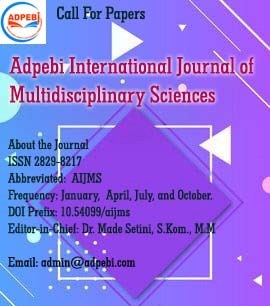Wind Resource for Electrical Energy of Tourism and Micro Small and Medium Enterprises (MSMEs) in Coastal Areas After the COVID-19 Pandemic
DOI:
https://doi.org/10.54099/aijms.v1i1.272Keywords:
Wind Resource for Electrical EnergyAbstract
The abstract should be clear and informative in one paragraph (between 150 and 250 words). Use Times New Romans font in size 10.
Purpose – This paper seeks to examine the The strategy to growth economical in coastal area that’s one of the areas more lovely designed to be a tourist destination in which is quite attractive to tourists, especially domestic tourists. The coastal area which is a fairly wide open landscape in the coastal area is very good for a source of wind energy that continues to feel the wind. Wind speed potential is used for wind power plant design data. In connection with many home industries that have started after Covid-19 Pandemic the independent use electrical energy, is one key to growth, so a source of electrical energy is needed that can be generated from the potential that exists around the community.
Methodology/approach – One way to increase MSMEs income is to reduce the cost of electrical energy for business needs. Electrical energy is obtained independently by utilizing the potential of its primary energy source, namely wind, which is quite large in coastal areas. To obtain wind potential data, data is collected using equipment that is adapted to the final destination in the form of place and time. Anemometer equipment is used to obtain wind speed data so that the condition of the wind speed in a place can be known.
Findings – It was found that The potential wind generated will be the basis for the design that will be used to design a wind turbine suitable for power generation. At that hour the wind has a speed of 2 m/s - 5 m/s. Effective hour that can operating turbine while wind speed flow continue in 10.00 AM until 04.00 AM day tomorrow. The existing wind speed will be adjusted according to the design of the turbine that will be used.
Novelty/value – Electrical energy from wind resources in coastal areas can save the cost of electricity needs for growing SMEs. Savings in electricity needs are obtained from wind turbines that can rotate at low speeds.
References
S
Dunne, F., & Simley, E. (2011). LIDAR Wind Speed Measurement Analysis and Feed-Forward Blade Pitch Control for Load Mitigation in Wind Turbines. (October).
Energy, A. W., & Association. (2001). Wind Energy Aplication Guide.
Giebel, G., Schlipf, D., & Kaifel, A. (2019). Minute-Scale Forecasting of Wind Power — Results from. https://doi.org/10.3390/en12040712
Haider, R., Alam, R., Yousuf, N. B., & Salim, K. M. (2012). Design and construction of single phase pure sine wave inverter for photovoltaic application. 2012 International Conference on Informatics, Electronics and Vision, ICIEV 2012, 190–194. https://doi.org/10.1109/ICIEV.2012.6317332
Ingenhorst, C., Jacobs, G., Stößel, L., Schelenz, R., & Juretzki, B. (2021). Method for airborne measurement of the spatial wind speed distribution above complex terrain. 427–440.
Irena International renewable Energy Agency. (2018). GLOBAL ENERGY.
Lawan, S. M., Abidin, W. A. W. Z., Chai, W. Y., Baharun, A., & Masri, T. (2014). Some methodologies of wind speed prediction : A critical review. 9(1).
Mauger, L. (2016). Generation Of Wind Speed And Solar Irradiance Time Series For Power Plants With Storage. Retrieved from http://www.diva-portal.org/smash/get/diva2:901909/FULLTEXT01.pdf
Myklebust, A. (2014). Dry Clutch Modeling , Estimation , and Control (Linkoping University Institute of Technology). Retrieved from https://www.fs.isy.liu.se/Publications/PhD/14_PhD_1612_AM.pdf
Robert Gasch Jochen Twele. (2012). Wind Power Plants, Fundamentals, Design, Construction and Operation. In R. Gasch (Ed.), Wind Power Plants (2nd ed.). https://doi.org/10.1007/978-3-642-22938-1
Sharma, S., Sellami, N., Tahir, A. A., & Mallick, T. K. (2021). Performance Improvement of a CPV System : Experimental. Energies Article.
Sheng, X., Wan, S., Cheng, K., & Wang, X. (2020). Research on the Fault Characteristic of Wind Turbine Generator System Considering the Spatiotemporal Distribution of the Actual Wind Speed.
Thresher, R., & Robinson, M. (2008). Wind Energy Technology : Current Status and R & D Future.
Tripp, C., Optis, M., & King, J. (2020). Short-term wind forecasting using statistical models with a fully observable wind flow. 1452, 1–12. https://doi.org/10.1088/1742-6596/1452/1/012083
Wiser, R., Bolinger, M., Hoen, B., Millstein, D., Rand, J., Barbose, G., … Paulos, B. (2020). Wind Energy Technology Data Update : 2020 Edition.
Yamaguchi, A. (2021). Maximum Instantaneous Wind Speed Forecasting and Performance Evaluation by Using Numerical Weather Prediction and On-Site Measurement.
Downloads
Published
How to Cite
Issue
Section
License
Copyright (c) 2022 Adpebi International Journal of Multidisciplinary Sciences

This work is licensed under a Creative Commons Attribution-NonCommercial 4.0 International License.










